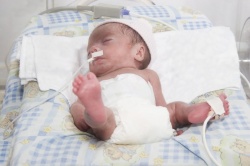Treatment protocol improves outcomes for infants with neonatal abstinence syndrome
A new protocol to treat babies born in withdrawal from drugs can be used widely to improve outcomes for these babies, says Eric Hall, a researcher in the Perinatal Institute at Cincinnati Children's and lead author of the study.

The protocol reduces length of stay and the duration of treatment with opioids that are used therapeutically to wean babies off of drugs.
"The incidence of neonatal abstinence syndrome after an infant's in utero exposure to opioids has risen dramatically in recent years," says Hall. "After adoption of the protocol, opioid treatment went from 34 to 23 days, and length of hospital inpatient stay dropped from nearly 32 days to about 24."
In all, 981 infants were included in the study, which ran from January 2012 to August 2014. At the beginning of the study, three of the hospitals implemented the new protocol, while three maintained their previous guidelines. In July 2013, all six hospitals used the new protocol. After August 2014, the researchers compared the six hospitals to the three that had maintained previous guidelines.
The researchers not only found an improvement in length of stay and duration of treatment, but also in adherence to the protocol, which increased from 87.9 percent to 96.7 percent.
The study is published online in the journal Pediatrics.
A recent article in The New England Journal of Medicine noted an increase in the admission for NAS to newborn intensive care units through 2004 to 2013 from seven cases per 1,000 admissions to 27 per 1,000 admissions. These infants are born in drug withdrawal - often in critical condition - having been exposed in utero to a range of opiates and opioids, from Percocet and Vicodin to heroin.
There is treatment for these babies, but only if they are detected before they go home. The problem is, symptoms do not occur for 48 hours, and many go home with their mothers just hours after birth with no one there to treat their withdrawal. They may end up failing to thrive, or in emergency departments with seizures.
This is why, in 2013, hospitals in the Cincinnati area became the first to begin widespread universal drug testing of all expectant mothers. Ohio law does not require notification of law enforcement if a maternal test is positive, unless there is suspicion of criminal behavior that directly affects the safety or well-being of the newborn. This diffuses the possibility of drug tests leading to criminal charges and increases the likelihood of expectant mothers agreeing to provide a urine sample.
"Prior to this program, one of four women using opioids went undetected. Today we are detecting nearly all," says Scott Wexelblatt, a pediatrician at Cincinnati Children's who has spearheaded the universal drug testing method. Dr. Wexelblatt was a co-author of Dr. Hall's study. Dr. Hall is also a researcher in the division of Biomedical Informatics at Cincinnati Children's.
Source: Cincinnati Children's Hospital Medical Center
14.09.2015


